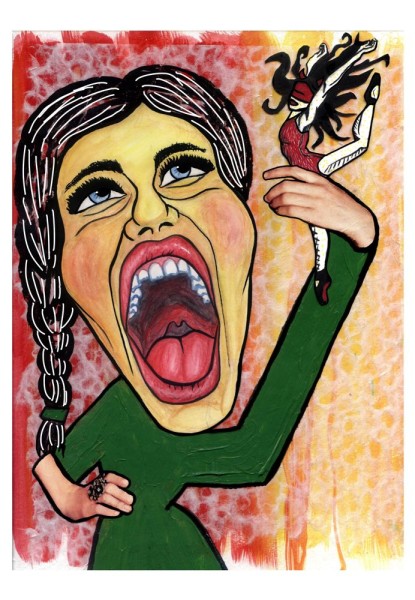I’m in charge. That’s what he tells me, placing a slim remote in my hand, cool and silver as a fish. It is outfitted with a single button that is not flush with the metal but fatly protrudes—in a now archaic way—above it, its surface dimpled and tempting, like on a joystick. A button that begs to be pushed.
I can push once, he explains, for discomfort. Twice for pain that verges on acute. Three times for a full stop. We can go as slow as we need to, he says. As slowly as we need to, I correct him in my mind. He asks me if I am numerical. I say that I am not, but he proceeds to explain how, on a scale of ten, one push is for pain from 2-4, two is for 5-7, and three is for 7-10. I don’t point out that he has repeated seven, that seven is an uncertain place, with respect to pushing, should I know with numerical certainty that my pain could be quantified at seven. What I want to know instead is the quality of the pain I may be subjected to, to know at the outset what I am surveying my body for. It is lying on my back, not seeing the instruments of pain, not understanding the nature of the pain, that is its own anticipatory horror. I grip the remote, wanting to test it. Will it beep when I push the button, signaling I have been heard? Will it be the pain of dentistry, numb and auditory, until without warning, there is a scream that only bones know, that seems to come from within, like you have been tunneled from tooth to pelvis? Or will it be pain that accumulates, the rat-a-tat-tat of a tattoo needle that begins as a near-pleasurable prick until the skin sores, swells too much to take more? Or should I expect the gynecological pressure that is adjacent to pain, the vascular quality that suggests something may burst—a pain more like the brain’s protest that the insides of the body are not meant to be touched?
It could be a new pain, as even a long life does not guarantee a full understanding of pain’s variety. Pain rests in the wings, a lithe little dancer waiting for her parents to arrive at the show. She will come out only when the time is right, showing you what she can do this year that she could not do last.
Don’t be a martyr, he says to me. I won’t, I say. But still I want to know, what is the average? How many times can I press this thing and still show I am tougher than most?
Would now be a good time, looking up at the acoustic tiles (that muffle what sounds from the floor above, I do not want to know) to admit that I have spent so much of my life in search of pain, hair tugged at the scalp, a pink breast, a wrist rubbed raw from being held back for so long, the pain that obliterates, like a white hot blast, actual hurt? That I’ve always needed more pain than I have received, but have chosen the kind of people who do not want to hurt me; that my prayers have been answered—but, lost in translation—this was not at all what I had in mind? It seems wrong to call that pain in the way this will be pain, and I would like to say that what I think I need is not a numeric scale but word choices, to parse out all these things lazily referred to by the same name.
And if, on the slim odds that it has been the kind of pain I’ve been looking for all along, the kind of pain that leads to forgetting, is there an underbutton on the belly of this thing, something I push to say, instead of stop, can you please give me more?


